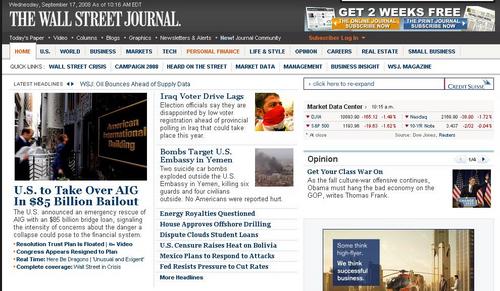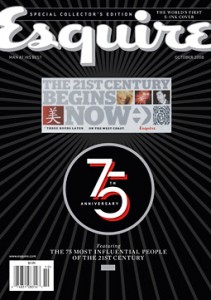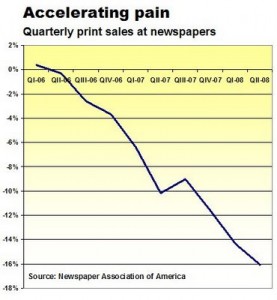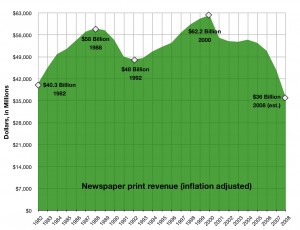About the only positive note in McClatchy Co.’s announcement that it will cut another 1,150 jobs is that the year-over-year decline in August revenues was a little better than in July. Other than that, what can you say? The stock, which closed at 60 as recently as early 2006, spiked briefly below $3 a share yesterday before recovering to close at $3.40. This is the third round of cost reductions this year by McClatchy, which operates 30 daily papers in the US. In June, it announced plans to cut its workforce by 1,400 people and on Sept. 1, it froze wages for a year. When the new cuts are completed, McClatchy will have reduced its workforce by about 16% this year. The company also cut its dividend for the first time in 20 years, saying that money would be better used to pay down its $2 billion debt.
There was a bit of good news. August revenue fell 15.7 percent from a year earlier to $142.8 million, and ad sales were down 17.8 percent. This was a bit of an improvement over July, when revenue fell 16.4 percent. Online ad revenue was also up 7.4%, bucking an alarming recent trend toward declines in that critical area for many newspaper companies.
Troubles at a newspaper parent are felt most strongly at the local level. The Sacramento Bee expects to avoid being hit by this latest round of layoffs, but it is eliminating nine regional sections and scaling back newsstand sales. The Bee has already cut 219 employees, or nearly 10% of its workforce, this year.
Another company that’s struggling to survive, Cox Newspapers, said it will sell 29 newspapers, including the Austin American-Statesman. The Austin paper is one of the jewels in the Cox crown, showing consistent profitability and strong online growth. The paper has pared headcount judiciously and has expanded into contract printing and direct mail. Hearst Corp. and private equity firm Austin Ventures.
The piece in the American-Statesman has some interesting tidbits. According to media analyst John Morton, publicly traded newspapers made a pre-tax average of 22 cents for every dollar of sales in 2003. In comparison, Dell Computer made about 5 cents on the dollar in its most recent quarter. Morton also said a rule of thumb for valuing a newspaper is $2,000 multiplied by the average daily circulation over a week. However, that ratio is probably much lower in the current economic climate. He added that five years ago, a newspaper typically sold at 12 or 13 times its pre-tax earnings, but that ratio is in the 5- to 7-times-earnings range today.
The news was not as good at Gannett Co., which reported that ad revenues in its publishing division were down 16.8% in August compared to last year. Repeating a familiar refrain, Gannett blamed the declines on a sharp drop in classified advertising revenue, which was down 28%. Real-estate advertising was off a mind-bending 40%, a figure that isn’t likely to improve amid the ongoing meltdown in the mortgage industry.
WSJ Evolves its Design
With online subscribership up 26% over the past two years and a growing base of visitors from social networks, The Wall Street Journal overhauled its website design this week. The most notable change is a departure from the print-like look of previous versions. The new site is horizontal, rather than vertical, and adopts the three-column structure used by USA Today and The Washington Post. One notable change is that all stories are now open to reader comments, a feature that was previously available only on blog entries. Each story now includes tabs for comments and multimedia elements, such as slide shows and video. There’s also a social network called Journal Community that mimics similar efforts by BusinessWeek and Fast Company.
Wired likes the new look, but notes that the Journal still hasn’t bitten the bullet on giving away content for free. It quotes an exec saying that the newspaper is gradually ratcheting open its paid content wall to new readers. It adds that subscriber-only articles have always been readable through a back door for free by searching on Google News. Firewalled articles are also accessible through a new BlackBerry application and links from social networks.
The New York Times notes that the redesigned site has more advertising units and sponsored sections. It’s more colorfull, features photography more prominently and has a moving newsreel with headlines and photos linking to related content.
We like it. In ditching its old design, the Journal has fallen into step with the look and feel of other news sites, which makes for easier navigation. The comments feature is a lso a nice touch. With all national newspapers now acceptin g user feedback, it’s wonder all newspapers don’t adopt this openness.

Layoff Log
- The Wichita Eagle laid off six employees and accepted voluntary buyouts from 16 others. That amounts to 6% of its employees. The paper offered voluntary buyouts to all full-time staff in August.
- Phoenix Newspapers, which publishes The Arizona Republic, announced 37 involuntary layoffs spread across several departments. That’s on top of 56 people who recently left in a buyout deal.









